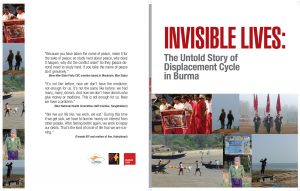INVISIBLE LIVES: The Untold Story of Displacement Cycle in Burma
By Burma Link, Burma Partnership and Human Rights Foundation of Monland • August 12, 2016 Recently, much attention surrounding Burma has focused on the democratic reform, 2015 elections and the future of the National League for Democracy (NLD)-led Government, whilst a profound humanitarian crisis and continuing concerns of the ethnic minority communities in the southeast have been largely ignored. The recent story of political and economic reform has insufficiently addressed the ongoing struggles of internally displaced persons (IDPs), as they become an inconvenient truth rendered invisible by the larger reform narrative.
Recently, much attention surrounding Burma has focused on the democratic reform, 2015 elections and the future of the National League for Democracy (NLD)-led Government, whilst a profound humanitarian crisis and continuing concerns of the ethnic minority communities in the southeast have been largely ignored. The recent story of political and economic reform has insufficiently addressed the ongoing struggles of internally displaced persons (IDPs), as they become an inconvenient truth rendered invisible by the larger reform narrative.
Nearly 70 years of ethnic conflict has created a displacement crisis with over 644,000 internally displaced and over 479,000 refugees fleeing the country predominantly from ethnic areas. At present, over 100,000 refugees live in camps along the Thailand-Burma border, and approximately 400,000 IDPs live in protracted displacement in southeast Burma. As the continuing political and social transformation in Burma and the triumph of the NLD in the 2015 elections captivates local citizens and foreign observers around the world, optimism and the infectious idea that those displaced will soon begin to move back to Burma has led to further decline in donor funding along the Thailand-Burma border.
Download the full report in English here.
Tags: Burma Link, Burma Partnership, Human Rights Foundation of Monland, Humanitarian Aid, Karen State, Mon State, Mon's IDPs, National League for Democracy, Nationwide Ceasefire Agreement, Refugees in Thai-Burma Border, Shan StateThis post is in: Children and Youth, Displacement, Economy, Ethnic Nationalities, Health, Human Rights, Law, Military Regime
Related PostsAnn Din Coal Power Plant: Local Movement and Action to Preserve and Protect Natural Resources and Land: Mon IDP Report Case Study #4
Burma Army Continues to Act with Impunity1: Case Study #3
Landmine Victim in Jo Haprao, Bee Ree: Mon IDP Report Case Study #2
Fleeing Sexual Violence from Yebyu Township to the Thailand-Burma Border: Mon IDP Report Case Study #1
New Report Urges Government to Address Protracted Displacement in Upcoming Panglong Conference









 All posts
All posts